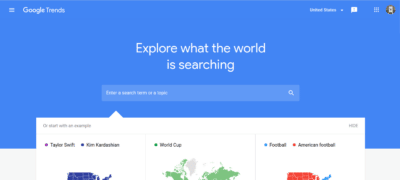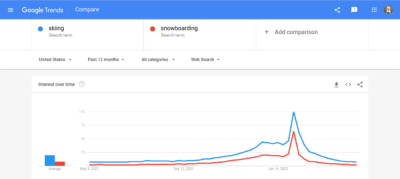Part 2: How To Rank Higher On Google Using Google Trends

By Prebuilt Sites Team
May 20, 2022
When you’re writing a blog post, two of the key things you need to know are:
- What keyword or keyword phrase you want the article to rank for
- When the best time to post is
In the first part of this three part series of blog posts going over the tips you learned in this episode of Prebuilt Power Hour on 10+ SEO Tricks You Can Use Right Now To Rank Higher On Google, we discussed how to use Google’s autocomplete functionality to know what to write about on your blog.
In this second part of the series, we discuss how to use Google Trends to determine how to phrase your keywords and know when the best time to post your content is.
You can watch the full episode of our Prebuilt Power Hour here. These free trainings take place on the 4th Thursday of every month at 12 Noon Central time, so be sure to mark your calendars and tune in!
How To Use Google Trends

Use Google Trends to determine how to phrase your keywords and know when the best time to target a particular keyphrase is.
Google Trends shows you how many search queries a keyword has had within a certain time frame. Google automatically sets this to 12 months, but you can change it if you wish.
Search query: the words that a user types into a search engine’s search bar
Using the example from our Prebuilt Power Hour, whenever you type in “keto” as a search term, you’ll see that Google Trends tells you how many times people searched for “keto” within the past 12 months. And that tells you how popular a search term (or search query) is.
Using Google Trends, you can also compare how popular a search query is in different geographical areas. Since most of our customers are based in the United States, we generally leave this on the United States.
You can even narrow your search into more specific queries to find better keywords to target. “Keto” is a pretty broad search term that sees a lot of traffic. So you can narrow this down to “keto recipes” and throw in several other terms such as “keto pizza” and “keto bread” to determine which keyword you wish to target.
Tips For Using Google Keyword Trends
Take Advantage of Seasonal Content
Pay attention to seasonal content to know when to post about certain topics.
For example, I have an outdoor adventure travel blog. As I’m sure you can assume, I’m not posting my content about the best ski resorts to visit in July. Instead, I’m writing guides on the best places to go paddle boarding, camping, and other outdoor activities that my audience may enjoy in the summertime.

If we look at this screenshot from Google Trends, you can see that people start searching for the term “skiing” right after Christmas and it peaks in the beginning February, when the powder is the best and everyone is out on the mountain.
Target keywords right before they get popular.
Now that you know that people start searching for skiing at the end of December, you probably think that you should be posting your ski content starting at the end of December. In reality, you should actually begin posting about skiing mid to end of November so that when people start searching for ski content, your article is at the top ready to go. If people are looking to go skiing in early February, they’re going to start planning their trips at least a month or two beforehand. So you want to make sure that when they’re planning their trips, they find your article already at the top.
And this can apply to any niche! Health coaches will want to get their content out a month or two well before early January so their articles have had some time to reach the top of the SERPs (search engine results pages) before everyone starts searching for weight loss content as their New Years resolution.
Compare different terms to decide which one to target
In the example from our Prebuilt Power Hour, we learn that people call the same object something different in different places. In Wisconsin, my coworkers call a drinking fountain a bubbler. So if most of their audience is in Wisconsin, they’re going to refer to a drinking fountain as a bubbler throughout their articles. If most of your users are American, you’ll need to refer to “American football” as “football”, but if most of your users are European you’ll need to use the term “football” to describe “soccer” and the term “American football” to reference what Americans refer to as just “football”.

You can also use this to compare interchangeable terms to see which you should use. For example, I ski and snowboard and both sports use the same trails, so they can generally be used interchangeably. But should I use the term “skiing” or “snowboarding”? As you can see above, by comparing the two in Google Trends, I see that the term “skiing” receives a lot more traffic than the term “snowboarding”. So I will talk about skiing more than snowboarding in my content.
I hope you found this to be helpful! In part three of this series, we are going to answer the question “how do I know which keywords are worth targeting?” by using the Google Keyword Planner.
You can watch the full episode of our Prebuilt Power Hour here. These free trainings take place on the 4th Thursday of every month at 12 Noon Central time, so be sure to mark your calendars and tune in!
Written By: Megan Fine

